Boyle J.A. The Cambridge History of Iran, Volume 5: The Saljuq and Mongol Periods
Подождите немного. Документ загружается.

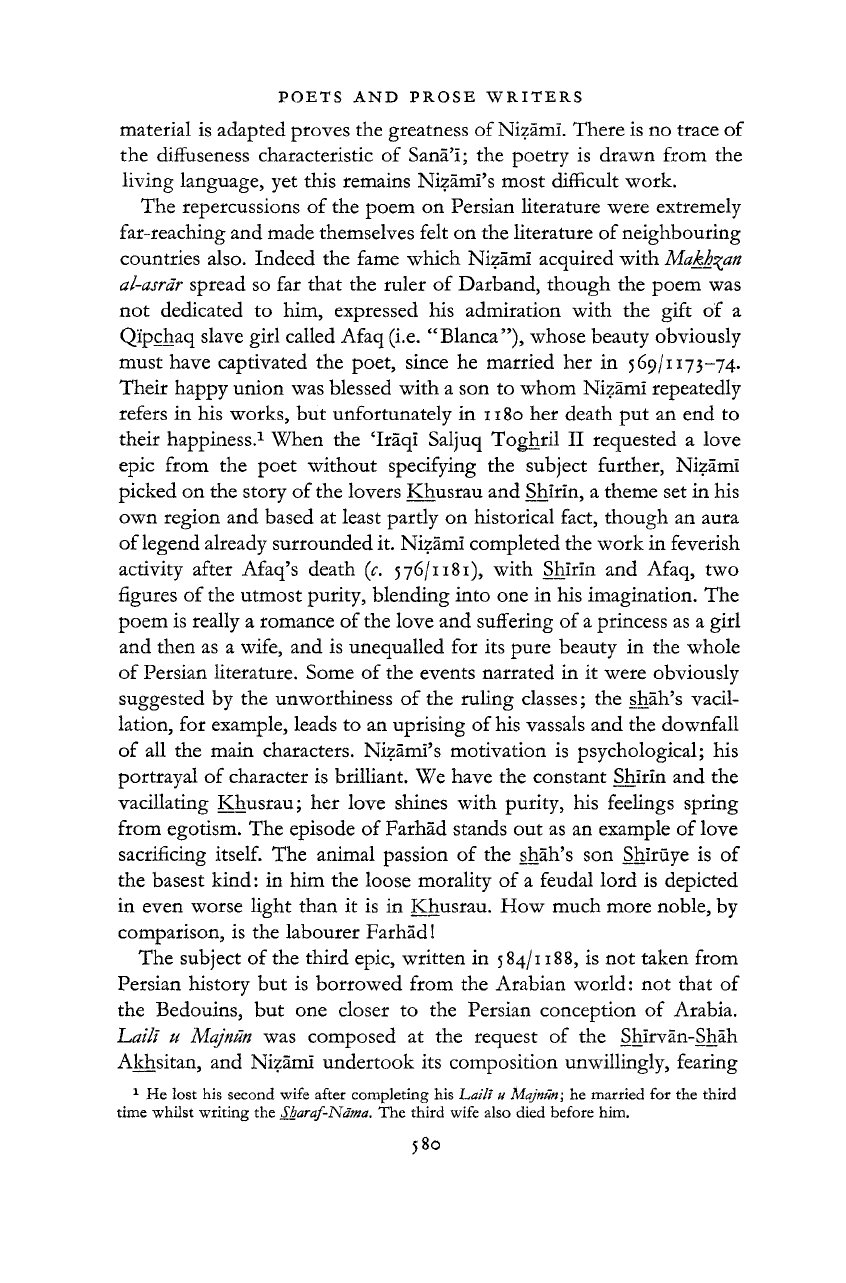
POETS
AND
PROSE WRITERS
580
material
is
adapted proves
the
greatness
of
Nizami. There
is no
trace
of
the diffuseness characteristic
of
Sanâ'i;
the
poetry
is
drawn from
the
living language,
yet
this remains Nizâmi's most difficult work.
The repercussions
of
the poem
on
Persian literature were extremely
far-reaching
and
made themselves felt
on the
literature
of
neighbouring
countries also. Indeed
the
fame w
T
hich Nizami acquired with
Makh^an
al-asrdr
spread
so far
that
the
ruler
of
Darband, though
the
poem
was
not dedicated
to him,
expressed
his
admiration with
the
gift
of a
Qipchaq slave girl called Afaq (i.e. "Blanca"), whose beauty obviously
must have captivated
the
poet, since
he
married
her in
569/1173-74.
Their happy union
was
blessed with
a son to
whom Nizami repeatedly
refers
in his
works,
but
unfortunately
in 1180 her
death
put an end to
their happiness.
1
When
the
'Iraqi Saljuq Toghril
II
requested
a
love
epic from
the
poet without specifying
the
subject further, Nizami
picked
on the
story
of
the lovers Khusrau and Shirin,
a
theme
set in his
own region
and
based
at
least partly
on
historical fact, though
an
aura
of legend already surrounded it. Nizami completed
the
work
in
feverish
activity after Afaq's death
(c.
576/1181), with Shirin
and
Afaq,
two
figures of the utmost purity, blending into
one in his
imagination.
The
poem
is
really
a
romance
of
the love
and
suffering
of
a princess
as a
girl
and then
as a
wife,
and is
unequalled
for its
pure beauty
in the
whole
of Persian literature. Some
of the
events narrated
in it
were obviously
suggested
by the
unworthiness
of the
ruling classes;
the
shah's vacil-
lation,
for
example, leads
to an
uprising
of
his vassals
and the
downfall
of
all the
main characters. Nizami's motivation
is
psychological;
his
portrayal
of
character
is
brilliant.
We
have
the
constant Shirin
and the
vacillating Khusrau;
her
love shines with purity,
his
feelings spring
from egotism.
The
episode
of
Farhâd stands
out as an
example
of
love
sacrificing
itself.
The
animal passion
of the
shâh's
son
Şhirüye
is of
the basest kind:
in him the
loose morality
of a
feudal lord
is
depicted
in even worse light than
it is in
Khusrau.
How
much more noble,
by
comparison,
is the
labourer Farhâd!
The subject
of
the third epic, written
in
584/1188,
is not
taken from
Persian history
but is
borrowed from
the
Arabian world:
not
that
of
the Bedouins,
but one
closer
to the
Persian conception
of
Arabia.
Lazlî u Majnün was
composed
at the
request
of the
Shirvân-Shâh
Akhsitan,
and
Nizami undertook
its
composition unwillingly, fearing
1
He
lost
his
second wife after completing
his
Lai/f
u
Majnün;
he
married
for the
third
time whilst writing
the
Sharaf-Nâma.
The
third wife also died before him.
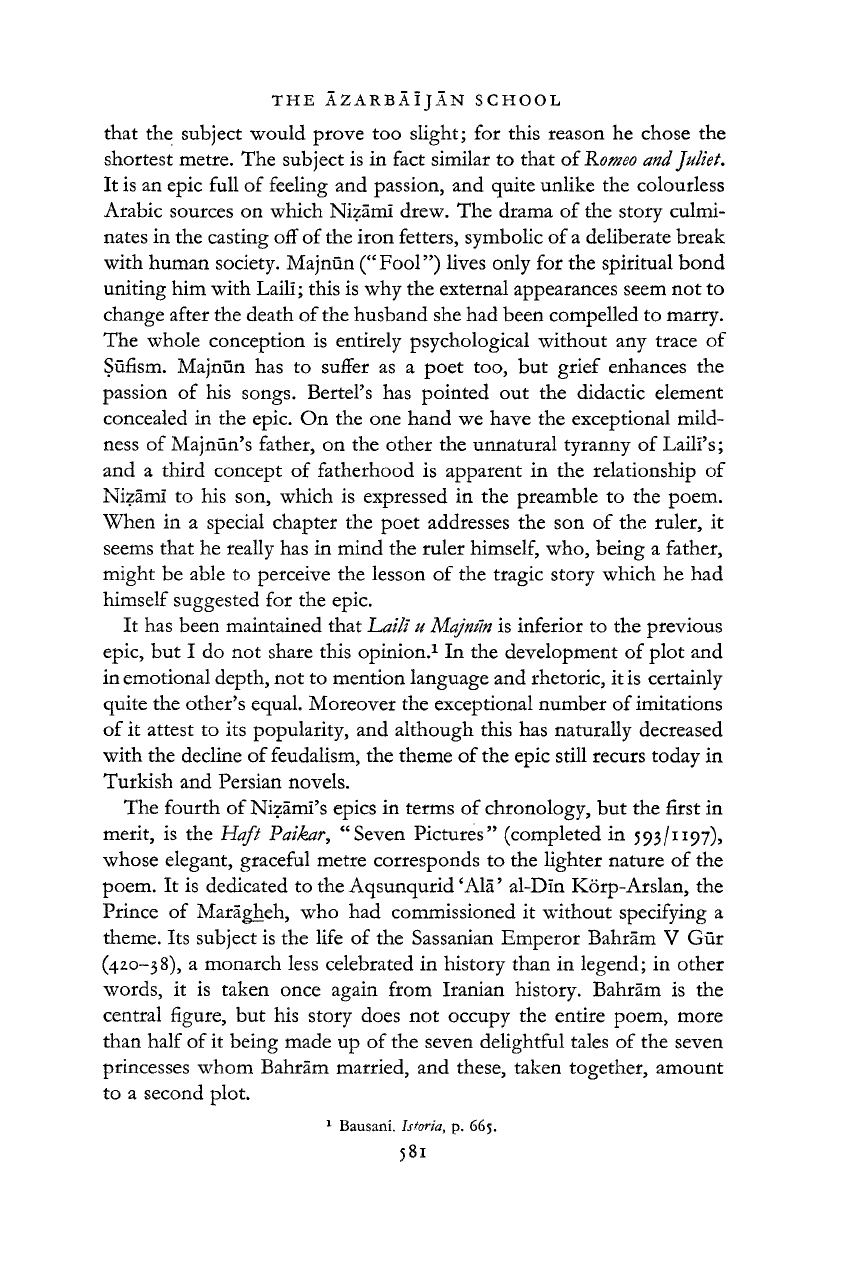
THE ÄZARBÄIJÄN SCHOOL
that
the
subject would prove
too
slight;
for
this reason
he
chose
the
shortest metre.
The
subject
is in
fact similar
to
that
of Romeo and
Juliet.
It
is an
epic full
of
feeling
and
passion,
and
quite unlike
the
colourless
Arabic sources
on
which Nizami drew.
The
drama
of
the story culmi-
nates
in the
casting
off of
the iron fetters, symbolic
of
a deliberate break
with human society. Majnün ("Fool") lives only
for the
spiritual bond
uniting him with Laili; this
is why the
external appearances seem
not to
change after the death
of
the husband she had been compelled
to
marry.
The whole conception
is
entirely psychological without
any
trace
of
Süfism. Majnün
has to
suffer
as a
poet
too, but
grief enhances
the
passion
of his
songs. Bertel's
has
pointed
out the
didactic element
concealed
in the
epic.
On the one
hand
we
have
the
exceptional mild-
ness
of
Majnün's father,
on the
other
the
unnatural tyranny
of
Laili's;
and
a
third concept
of
fatherhood
is
apparent
in the
relationship
of
Nizämi
to his son,
which
is
expressed
in the
preamble
to the
poem.
When
in a
special chapter
the
poet addresses
the son of the
ruler,
it
seems that
he
really
has in
mind
the
ruler himself,
who,
being
a
father,
might
be
able
to
perceive
the
lesson
of the
tragic story which
he had
himself suggested
for the
epic.
It
has
been maintained that
Laili u Majnün is
inferior
to the
previous
epic,
but I do not
share this opinion.
1
In the
development
of
plot
and
in emotional depth,
not to
mention language
and
rhetoric, it is certainly
quite
the
other's equal. Moreover
the
exceptional number
of
imitations
of
it
attest
to its
popularity,
and
although this
has
naturally decreased
with
the
decline
of
feudalism,
the
theme
of
the epic still recurs today
in
Turkish
and
Persian novels.
The fourth
of
Nizärni's epics
in
terms
of
chronology,
but the
first
in
merit,
is the Haft
Paikar,
"Seven Pictures" (completed
in
593/1197),
whose elegant, graceful metre corresponds
to the
lighter nature
of the
poem.
It is
dedicated
to
the Aqsunqurid *Alä' al-Din Körp-Arslan,
the
Prince
of
Marägheh,
who had
commissioned
it
without specifying
a
theme.
Its
subject
is the
life
of the
Sassanian Emperor Bahräm
V Gür
(420-38),
a
monarch less celebrated
in
history than
in
legend;
in
other
words,
it is
taken once again from Iranian history. Bahräm
is the
central figure,
but his
story does
not
occupy
the
entire poem, more
than half
of it
being made
up of
the seven delightful tales
of the
seven
princesses whom Bahräm married,
and
these, taken together, amount
to
a
second plot.
1
Bausani. Istoria,
p. 665.
581
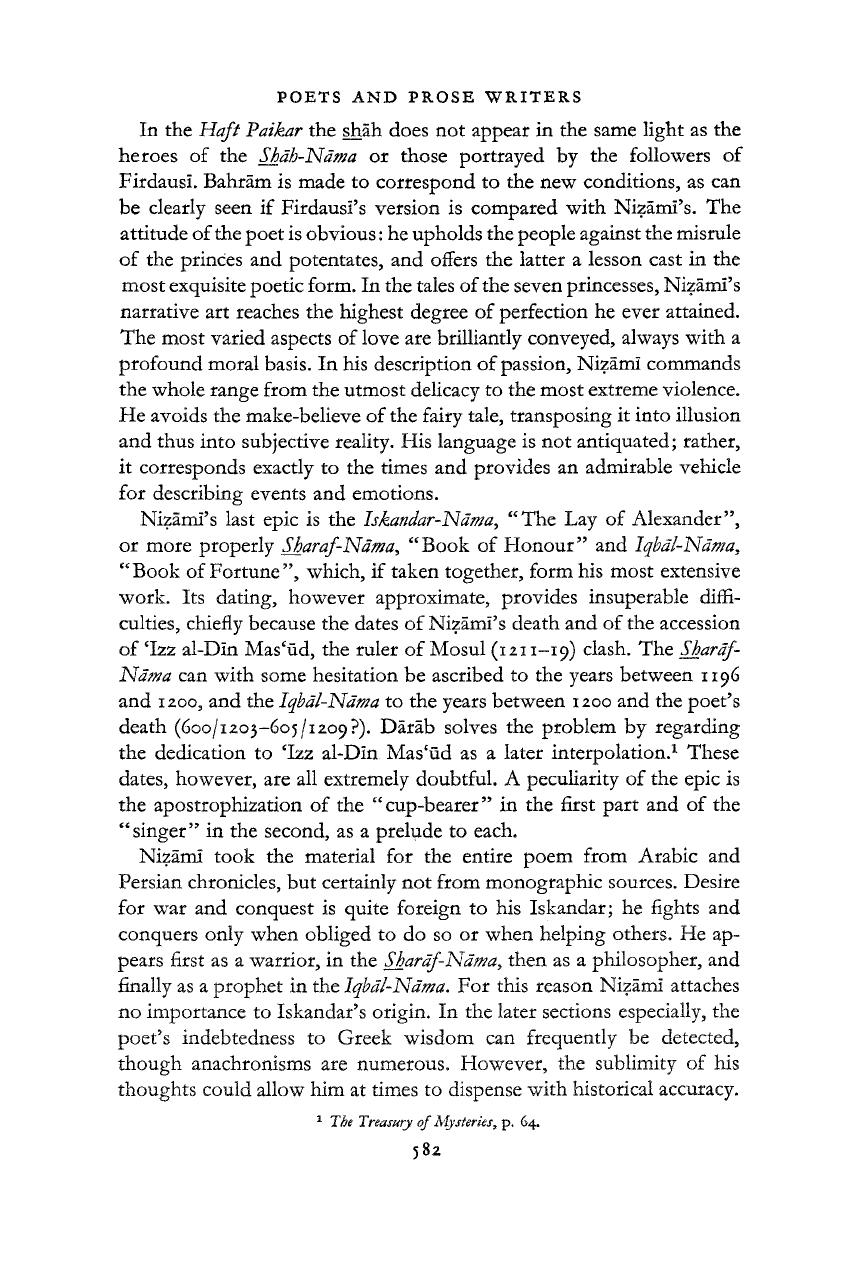
POETS
AND
PROSE WRITERS
582
In
the Haft Paikar the
shah does
not
appear
in the
same light
as the
heroes
of the Shah-Nam a or
those portrayed
by the
followers
of
Firdausi. Bahram
is
made
to
correspond
to the new
conditions,
as can
be clearly seen
if
Firdausf s version
is
compared with Nizamfs.
The
attitude of the poet is obvious: he upholds the people against the misrule
of
the
princes
and
potentates,
and
offers
the
latter
a
lesson cast
in the
most exquisite poetic form.
In
the tales
of
the seven princesses, Nizamfs
narrative
art
reaches
the
highest degree
of
perfection
he
ever attained.
The most varied aspects
of
love
are
brilliantly conveyed, always with
a
profound moral basis.
In
his description
of
passion, Nizami commands
the whole range from the utmost delicacy
to the
most extreme violence.
He avoids
the
make-believe
of
the fairy tale, transposing
it
into illusion
and thus into subjective reality.
His
language
is not
antiquated; rather,
it corresponds exactly
to the
times
and
provides
an
admirable vehicle
for describing events
and
emotions.
Nizamfs last epic
is the Iskandar-Ndma, "The Lay of
Alexander",
or more properly
Sharaf-Ndma,
"Book
of
Honour"
and Iqbdl-Ndma,
"Book
of
Fortune", which,
if
taken together, form his most extensive
work.
Its
dating, however approximate, provides insuperable diffi-
culties, chiefly because
the
dates
of
Nizamfs death
and of
the accession
of
£
Izz al-Din Mas'ud,
the
ruler
of
Mosul (1211-19) clash.
The
Shardf-
Ndma can
with some hesitation
be
ascribed
to the
years between
1196
and 1200,
and the Iqbdl-Ndma to the
years between 1200
and the
poet's
death (600/1203-605/1209?). Darab solves
the
problem
by
regarding
the dedication
to 'Izz
al-Din Mas'ud
as a
later interpolation.
1
These
dates,
however,
are all
extremely doubtful.
A
peculiarity
of
the epic
is
the apostrophization
of the
"cup-bearer"
in the
first part
and of the
"singer"
in the
second,
as a
prelude
to
each.
Nizami took
the
material
for the
entire poem from Arabic
and
Persian chronicles,
but
certainly
not
from monographic sources. Desire
for
war and
conquest
is
quite foreign
to his
Iskandar;
he
fights
and
conquers only when obliged
to do so or
when helping others.
He ap-
pears first
as a
warrior,
in the Shardf-Ndma,
then
as a
philosopher,
and
finally as
a
prophet
in
the
Iqbdl-Ndma. For
this reason Nizami attaches
no importance
to
Iskandar's origin.
In the
later sections especially,
the
poet's indebtedness
to
Greek wisdom
can
frequently
be
detected,
though anachronisms
are
numerous. However,
the
sublimity
of his
thoughts could allow him
at
times
to
dispense with historical accuracy.
1
The
Treasury
of
Mysteries,
p.
64.
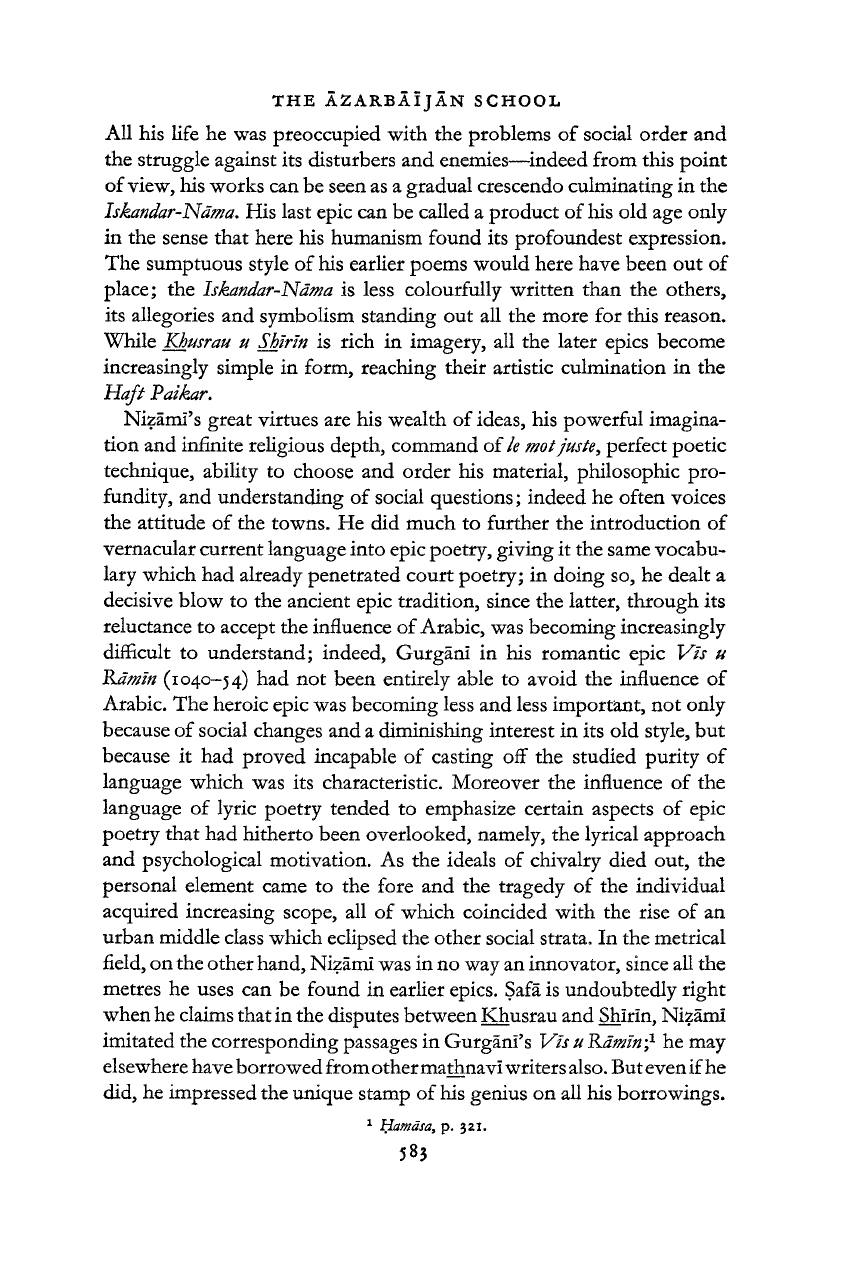
THE AZARBÁIJAN SCHOOL
583
All
his
life
he was
preoccupied with
the
problems
of
social order
and
the struggle against
its
disturbers
and
enemies—indeed from this point
of view, his works can
be
seen as
a
gradual crescendo culminating
in the
Iskandar-Nama. His
last epic can
be
called
a
product
of
his
old age
only
in
the
sense that here
his
humanism found
its
profoundest expression.
The sumptuous style
of
his earlier poems would here have been
out of
place;
the Iskandar-Nama is
less colourfully written than
the
others,
its allegories
and
symbolism standing
out all the
more
for
this reason.
While
Khusrau u Shirin is
rich
in
imagery,
all the
later epics become
increasingly simple
in
form, reaching their artistic culmination
in the
Haft
Paikar.
Nizamfs great virtues
are his
wealth
of
ideas,
his
powerful imagina-
tion and infinite religious depth, command
of le mot juste
y
perfect poetic
technique, ability
to
choose
and
order
his
material, philosophic pro-
fundity,
and
understanding
of
social questions; indeed
he
often voices
the attitude
of the
towns.
He did
much
to
further
the
introduction
of
vernacular current language into epic poetry, giving
it
the same vocabu-
lary which
had
already penetrated court poetry;
in
doing
so, he
dealt
a
decisive blow
to the
ancient epic tradition, since
the
latter, through
its
reluctance
to
accept
the
influence
of
Arabic,
was
becoming increasingly
difficult
to
understand; indeed, Gurgani
in his
romantic epic
Vis u
Rdmin
(1040-54)
had not
been entirely able
to
avoid
the
influence
of
Arabic.
The
heroic epic was becoming less and less important,
not
only
because
of
social changes and
a
diminishing interest
in its old
style,
but
because
it had
proved incapable
of
casting
off the
studied purity
of
language which
was its
characteristic. Moreover
the
influence
of the
language
of
lyric poetry tended
to
emphasize certain aspects
of
epic
poetry that
had
hitherto been overlooked, namely,
the
lyrical approach
and psychological motivation.
As the
ideals
of
chivalry died
out, the
personal element came
to the
fore
and the
tragedy
of the
individual
acquired increasing scope,
all of
which coincided with
the
rise
of an
urban middle class which eclipsed
the
other social strata.
In the
metrical
field, on the other hand, Nizámi was in no way an innovator, since all
the
metres
he
uses
can be
found
in
earlier epics. Safa
is
undoubtedly right
when he claims that in the disputes between Khusrau and Shirin, Nizámi
imitated the corresponding passages
in
Gurgánfs
Vis u Ramin;
1
he may
elsewhere have borrowed from other mathnavi writers
also.
But even if he
did,
he
impressed the unique stamp
of
his genius
on all his
borrowings.
1
Hamasa,
p. 321.
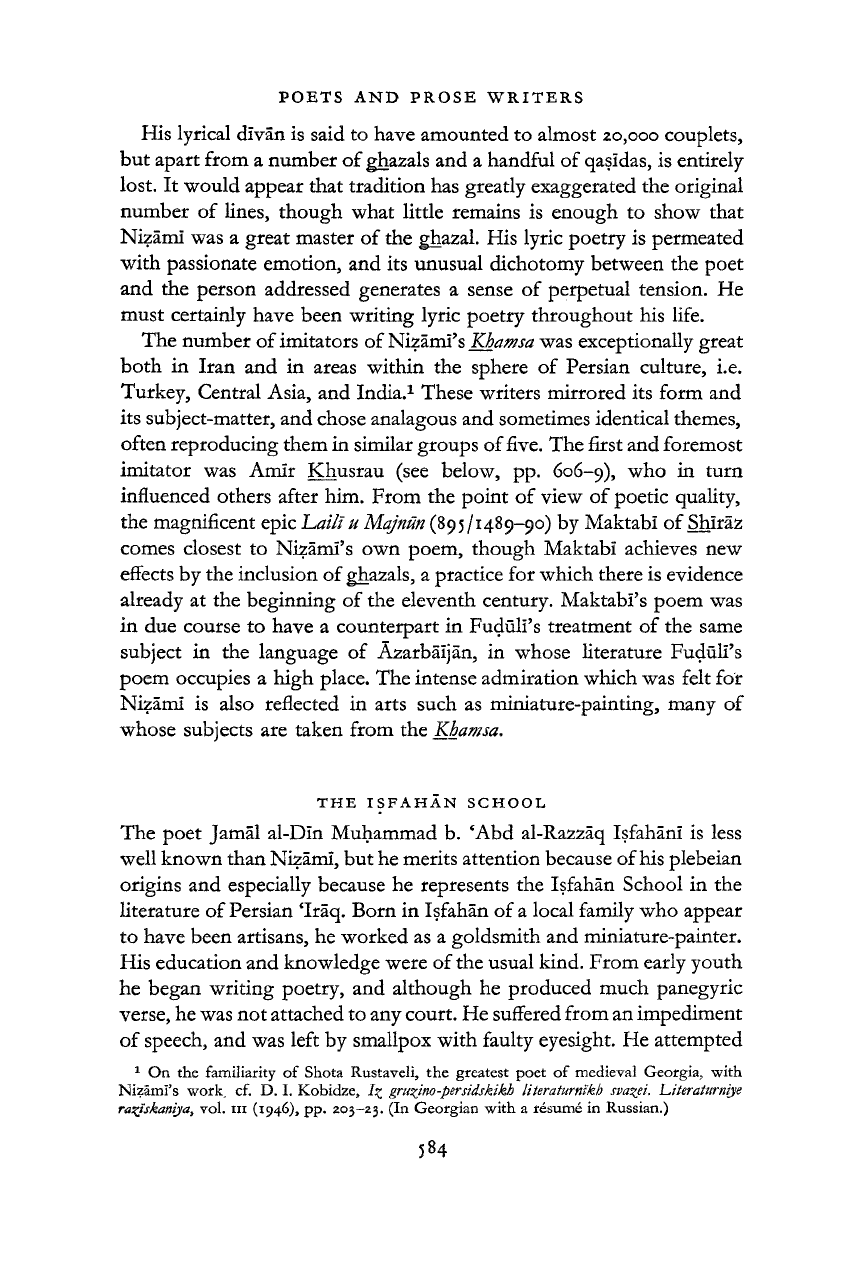
POETS
AND
PROSE WRITERS
His lyrical divân
is
said
to
have amounted
to
almost 20.000 couplets,
but apart from
a
number
of
ghazals and
a
handful
of
qasidas,
is
entirely
lost.
It
would appear that tradition has greatly exaggerated
the
original
number
of
lines, though what little remains
is
enough
to
show that
Nizami
was a
great master
of
the ghazal.
His
lyric poetry
is
permeated
with passionate emotion,
and its
unusual dichotomy between
the
poet
and
the
person addressed generates
a
sense
of
perpetual tension.
He
must certainly have been writing lyric poetry throughout
his
life.
The number
of
imitators
of
Nizami's
Khamsa
was exceptionally great
both
in
Iran
and in
areas within
the
sphere
of
Persian culture,
i.e.
Turkey, Central Asia,
and
India.
1
These writers mirrored
its
form
and
its subject-matter, and chose analagous and sometimes identical themes,
often reproducing them in similar groups
of
five.
The
first and foremost
imitator
was
Amir Khusrau
(see
below,
pp.
606-9),
who in
turn
influenced others after him. From
the
point
of
view
of
poetic quality,
the magnificent epic
Lailîu Majnün
(895/1489-90)
by
Maktabi
of
Shirâz
comes closest
to
Nizâmi's
own
poem, though Maktabi achieves
new
effects
by
the inclusion
of
ghazals,
a
practice
for
which there
is
evidence
already
at the
beginning
of
the eleventh century. Maktabi's poem
was
in
due
course
to
have
a
counterpart
in
Fudüli's treatment
of the
same
subject
in the
language
of
Âzarbâijân,
in
whose literature Fudüli's
poem occupies
a
high place. The intense admiration which was felt
for
Nizamî
is
also reflected
in
arts such
as
miniature-painting, many
of
whose subjects
are
taken from
the Khamsa.
THE ISFAHAN SCHOOL
The poet Jamal al-Din Muhammad
b. 'Abd
al-Razzaq Isfahani
is
less
well known than Nizarni, but he merits attention because
of
his plebeian
origins
and
especially because
he
represents
the
Isfahan School
in the
literature
of
Persian 'Iraq. Born
in
Isfahan
of
a local family who appear
to have been artisans,
he
worked
as a
goldsmith
and
miniature-painter.
His education and knowledge were
of
the usual kind. From early youth
he began writing poetry,
and
although
he
produced much panegyric
verse, he was not attached
to
any court.
He
suffered from an impediment
of speech,
and was
left
by
smallpox with faulty eyesight.
He
attempted
1
On the
familiarity
of
Shota Rustaveli,
the
greatest poet
of
medieval Georgia, with
Nizami's work,
cf. D. I.
Kobidze, 1% grufino-persidskikh literaturnikh sva^ei. Literaturniye
razfskamya, vol.
in
(1946), pp. 203-23.
(*
n
Georgian with
a
resume
in
Russian.)
584
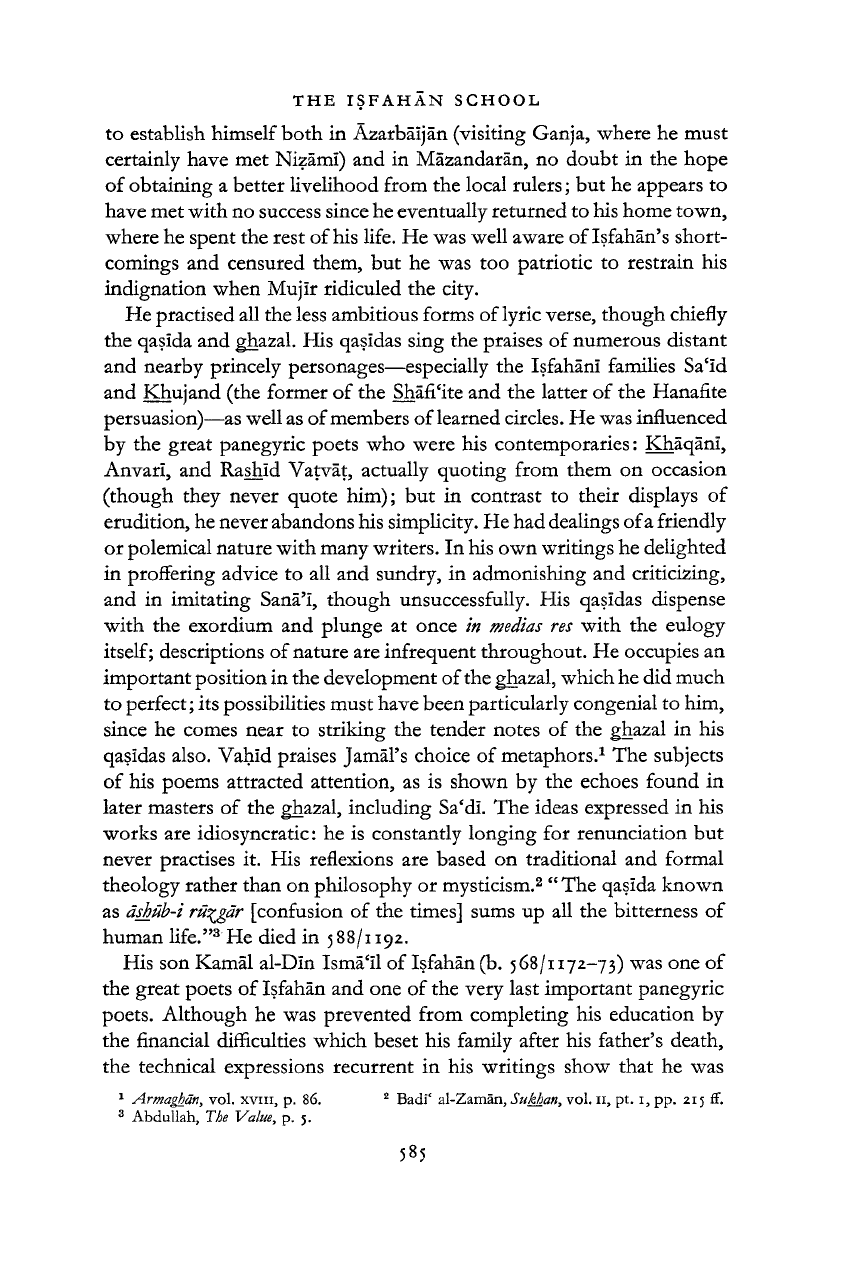
THE ISFAHAN SCHOOL
to establish himself both
in
Àzarbàïjàn (visiting Ganja, where
he
must
certainly have
met
Nizami)
and in
Màzandaràn,
no
doubt
in the
hope
of obtaining
a
better livelihood from
the
local rulers;
but he
appears
to
have met with no success since he eventually returned
to
his home town,
where
he
spent
the
rest
of
his life.
He
was well aware
of
Isfahan's short-
comings
and
censured them,
but he was too
patriotic
to
restrain
his
indignation when Mujir ridiculed
the
city.
He practised all the less ambitious forms
of
lyric verse, though chiefly
the qasida
and
ghazal.
His
qasidas sing
the
praises
of
numerous distant
and nearby princely personages—especially
the
Isfahan! families Sa'id
and Khujand
(the
former
of the
Shàfi'ite
and the
latter
of the
Hanafite
persuasion)—as well as of members of learned circles.
He
was influenced
by
the
great panegyric poets
who
were
his
contemporaries: Khaqani,
Anvari,
and
Rashïd Vatvàt, actually quoting from them
on
occasion
(though they never quote
him); but in
contrast
to
their displays
of
erudition, he never abandons his simplicity.
He
had dealings of a friendly
or polemical nature with many writers.
In
his own writings
he
delighted
in proffering advice
to all and
sundry,
in
admonishing
and
criticizing,
and
in
imitating Sana'i, though unsuccessfully.
His
qasidas dispense
with
the
exordium
and
plunge
at
once
in medias res
with
the
eulogy
itself;
descriptions
of
nature are infrequent throughout.
He
occupies
an
important position in the development of the ghazal, which he did much
to perfect; its possibilities must have been particularly congenial
to
him,
since
he
comes near
to
striking
the
tender notes
of the
ghazal
in his
qasidas also. Vahid praises Jamal's choice
of
metaphors.
1
The
subjects
of
his
poems attracted attention,
as is
shown
by the
echoes found
in
later masters
of the
ghazal, including Sa'di.
The
ideas expressed
in his
works
are
idiosyncratic:
he is
constantly longing
for
renunciation
but
never practises
it. His
reflexions
are
based
on
traditional
and
formal
theology rather than
on
philosophy
or
mysticism.
2
"
The qasida known
as
dshüb-i rü^gàr
[confusion
of the
times] sums
up all the
bitterness
of
human life."
3
He
died
in
588/1192.
His
son
Kamàl al-Din Isma'il
of
Isfahan (b. 568/1172-73)
was one of
the great poets
of
Isfahan
and one of
the very last important panegyric
poets.
Although
he was
prevented from completing
his
education
by
the financial difficulties which beset
his
family after
his
father's death,
the technical expressions recurrent
in his
writings show that
he was
1
Armaghdn,
vol.
xvm,
p. 86.
2
Badf al-Zaman. Sukhan
y
vol. 11,
pt. 1,
pp.
215 S.
3
Abdullah,
The
Value,
p. 5.
585
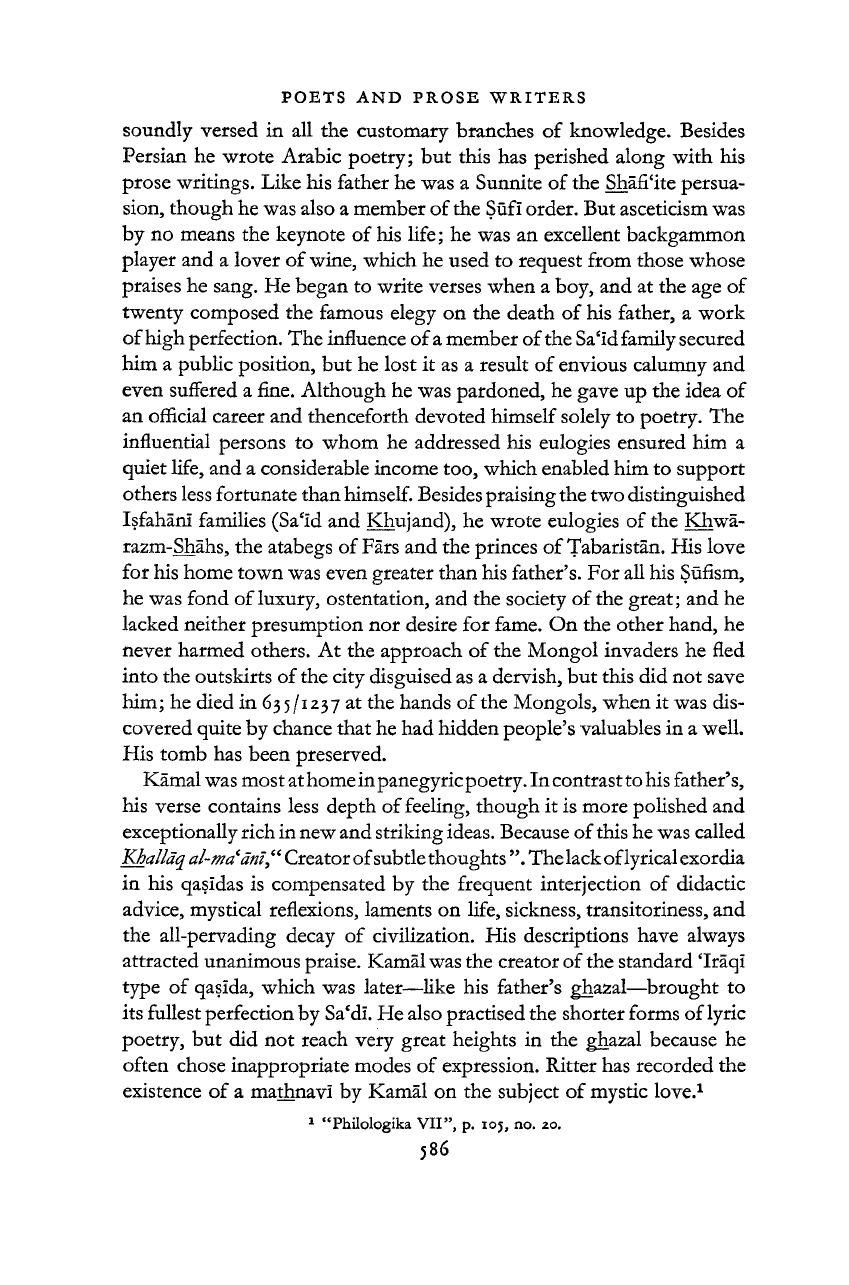
POETS
AND
PROSE WRITERS
soundly versed
in all the
customary branches
of
knowledge. Besides
Persian
he
wrote Arabic poetry;
but
this
has
perished along with
his
prose writings. Like
his
father
he was a
Sunnite
of
the Shafi'ite persua-
sion, though
he
was also
a
member
of
the Sufi order. But asceticism was
by
no
means
the
keynote
of
his life;
he was an
excellent backgammon
player
and a
lover
of
wine, which
he
used
to
request from those whose
praises
he
sang.
He
began
to
write verses when
a
boy,
and at the age of
twenty composed
the
famous elegy
on the
death
of
his father,
a
work
of high perfection. The influence of a member of the Sa'id family secured
him
a
public position,
but he
lost
it as a
result
of
envious calumny
and
even suffered
a
fine. Although
he was
pardoned,
he
gave
up the
idea
of
an official career
and
thenceforth devoted himself solely
to
poetry.
The
influential persons
to
whom
he
addressed
his
eulogies ensured
him a
quiet life, and
a
considerable income too, which enabled him
to
support
others less fortunate than himself. Besides praising the two distinguished
Isfahan! families (Sa
c
id
and
Khujand),
he
wrote eulogies
of
the Khwa-
razm-Shahs,
the
atabegs
of
Fars
and the
princes
of
Tabaristan,
His
love
for his home town was even greater than his father's.
For
all his Sufism,
he
was
fond
of
luxury, ostentation,
and the
society
of
the great;
and he
lacked neither presumption
nor
desire
for
fame.
On the
other hand,
he
never harmed others.
At the
approach
of
the Mongol invaders
he
fled
into
the
outskirts
of
the city disguised as
a
dervish,
but
this did not save
him;
he
died
in
635/1237
at the
hands
of
the Mongols, when
it
was dis-
covered quite
by
chance that
he
had hidden people's valuables
in a
well.
His tomb
has
been preserved.
Kamal was most at home in panegyric poetry. In contrast to his father's,
his verse contains less depth
of
feeling, though
it is
more polished
and
exceptionally rich in new and striking ideas. Because of this
he
was called
Khalldq al-ma
c
dm"
Creator of subtle thoughts
".
The lack oflyrical exordia
in
his
qasidas
is
compensated
by the
frequent interjection
of
didactic
advice, mystical reflexions, laments
on
life, sickness, transitoriness,
and
the all-pervading decay
of
civilization.
His
descriptions have always
attracted unanimous praise. Kamal was the creator
of
the standard "Iraqi
type
of
qasida, which
was
later—like
his
father's ghazal—brought
to
its fullest perfection
by
Sa'di.
He
also practised the shorter forms of lyric
poetry,
but did not
reach very great heights
in the
ghazal because
he
often chose inappropriate modes
of
expression. Ritter has recorded
the
existence
of a
mathnavi
by
Kamal
on the
subject
of
mystic love.
1
1
"Philologika VII",
p.
105, no.
20.
586
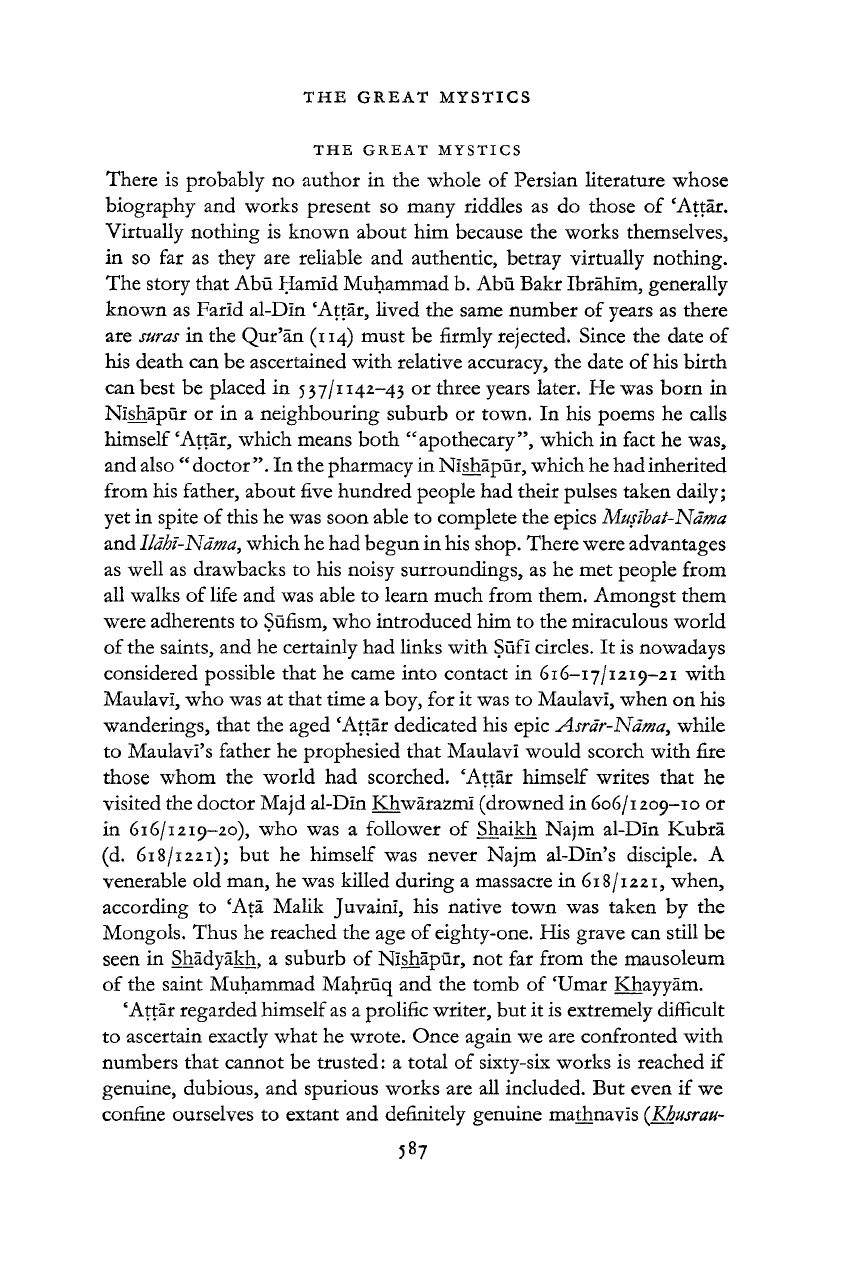
THE GREAT MYSTICS
THE GREAT MYSTICS
There
is
probably
no
author
in the
whole
of
Persian literature whose
biography
and
works present
so
many riddles
as do
those
of
'Attar.
Virtually nothing
is
known about
him
because
the
works themselves,
in
so far as
they
are
reliable
and
authentic, betray virtually nothing.
The story that Abu. Hamid Muhammad b. Abu. Bakr Ibrahim, generally
known
as
Farid al-Din 'Attar, lived
the
same number
of
years
as
there
are
suras in the
Qur'an (114) must
be
firmly rejected. Since
the
date
of
his death can
be
ascertained with relative accuracy,
the
date
of
his birth
can best
be
placed
in
5
37/1142-43
or
three years later.
He
was born
in
Nishapur
or in a
neighbouring suburb
or
town.
In his
poems
he
calls
himself 'Attar, which means both "apothecary", which
in
fact
he was,
and also
"
doctor ".
In
the pharmacy in Nishapur, which he had inherited
from his father, about five hundred people
had
their pulses taken daily;
yet
in
spite
of
this
he
was soon able
to
complete
the
epics
Musibat-Ndma
and
Ildhi-Ndma,
which he had begun
in
his shop. There were advantages
as well
as
drawbacks
to his
noisy surroundings,
as he met
people from
all walks
of
life
and
was able
to
learn much from them. Amongst them
were adherents
to
Sufism,
who
introduced him
to the
miraculous world
of the saints, and
he
certainly had links with Sufi circles.
It is
nowadays
considered possible that
he
came into contact
in
616-17/1219-21 with
Maulavi,
who
was
at
that time
a
boy,
for it
was
to
Maulavi, when
on his
wanderings, that
the
aged 'Attar dedicated
his
epic
Asrdr-Ndwa,
while
to Maulavi's father
he
prophesied that Maulavi would scorch with fire
those whom
the
world
had
scorched. 'Attar himself writes that
he
visited the doctor Majd al-Din Khwarazmi (drowned
in
606/1209-10
or
in 616/1219-20),
who was a
follower
of
Shaikh Najm al-Din Kubra
(d. 618/1221);
but he
himself
was
never Najm al-Din's disciple.
A
venerable
old
man,
he
was killed during
a
massacre
in
618/1221, when,
according
to 'Ata
Malik Juvaini,
his
native town
was
taken
by the
Mongols. Thus
he
reached
the age of
eighty-one.
His
grave
can
still
be
seen
in
Shadyakh,
a
suburb
of
Nishapur,
not far
from
the
mausoleum
of
the
saint Muhammad Mahruq
and the
tomb
of
'Umar Khayyam.
'Attar regarded himself as
a
prolific writer, but
it is
extremely difficult
to ascertain exactly what
he
wrote. Once again
we are
confronted with
numbers that cannot
be
trusted:
a
total
of
sixty-six works
is
reached
if
genuine, dubious,
and
spurious works
are all
included.
But
even
if we
confine ourselves
to
extant
and
definitely genuine mathnavis
(Khusrau-
587
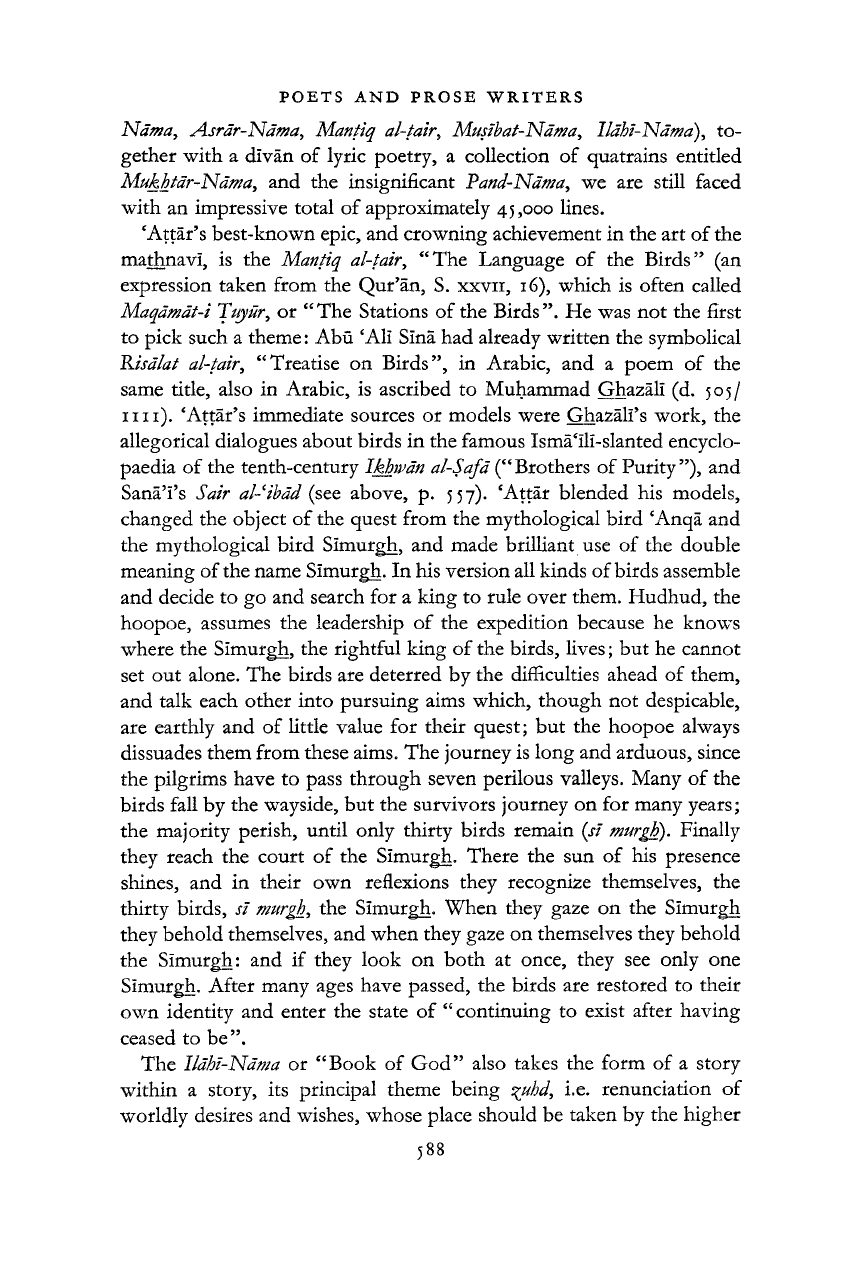
POETS
AND
PROSE WRITERS
588
Nâma, Asrâr-Nâma, Mantiq
al~tair,
Muşîbat-Nâma, Ilâhi-Nâmd),
to-
gether with
a
divan
of
lyric poetry,
a
collection
of
quatrains entitled
Mukhtdr-Ndma,
and the
insignificant
Pand-Ndma,
we are
still faced
with
an
impressive total
of
approximately 45,000 lines.
'Attar's best-known epic,
and
crowning achievement
in the art
of
the
mathnavi,
is the
Mantiq
al-tair, "The
Language
of the
Birds"
(an
expression taken from
the
Qur'àn,
S.
XXVII,
16),
which
is
often called
Maqâmât-i T
uyur,
or
"The
Stations
of
the Birds".
He
was not the
first
to pick such
a
theme:
Abü
'Ali
Sina
had
already written
the
symbolical
Risdlat
al-tair,
"Treatise
on
Birds",
in
Arabic,
and a
poem
of the
same title, also
in
Arabic,
is
ascribed
to
Muhammad Ghazàli
(d. 505/
mi).
'Attar's immediate sources
or
models were Ghazàlï's work,
the
allegorical dialogues about birds
in
the famous Ismà'ïlí-slanted encyclo-
paedia
of
the
tenth-century
Ikhwdn al-Şafâ
("Brothers
of
Purity"),
and
Sanâ'i's
Sair al-ibdd (see
above,
p. 557).
'Attar blended
his
models,
changed
the
object
of
the quest from
the
mythological bird 'Anqa
and
the mythological bird Simurgh,
and
made brilliant
use of
the
double
meaning
of
the name Simurgh.
In
his version
all
kinds
of
birds assemble
and decide
to go
and
search
for a
king
to
rule over them. Hudhud,
the
hoopoe, assumes
the
leadership
of the
expedition because
he
knows
where
the
Simurgh,
the
rightful king
of
the birds, lives;
but
he
cannot
set
out
alone.
The
birds
are
deterred
by
the
difficulties ahead
of
them,
and talk each other into pursuing aims which, though
not
despicable,
are earthly
and of
little value
for
their quest;
but the
hoopoe always
dissuades them from these aims.
The
journey
is
long and arduous, since
the pilgrims have
to
pass through seven perilous valleys. Many
of
the
birds fall
by
the
wayside,
but the
survivors journey
on for
many years;
the majority perish, until only thirty birds remain
{si
murgh).
Finally
they reach
the
court
of the
Simurgh. There
the sun of his
presence
shines,
and in
their
own
reflexions they recognize themselves,
the
thirty birds,
si
murgh,
the
Simurgh. When they gaze
on the
Simurgh
they behold themselves, and when they gaze
on
themselves they behold
the Simur
gh:
and if
they look
on
both
at
once, they
see
only
one
Simurgh. After many ages have passed,
the
birds
are
restored
to
their
own identity
and
enter
the
state
of "
continuing
to
exist after having
ceased
to
be".
The
Ilâhi-Nâma
or
"Book
of
God"
also takes
the
form
of a
story
within
a
story,
its
principal theme being
%uhd, i.e.
renunciation
of
worldly desires
and
wishes, whose place should
be
taken
by
the
higher
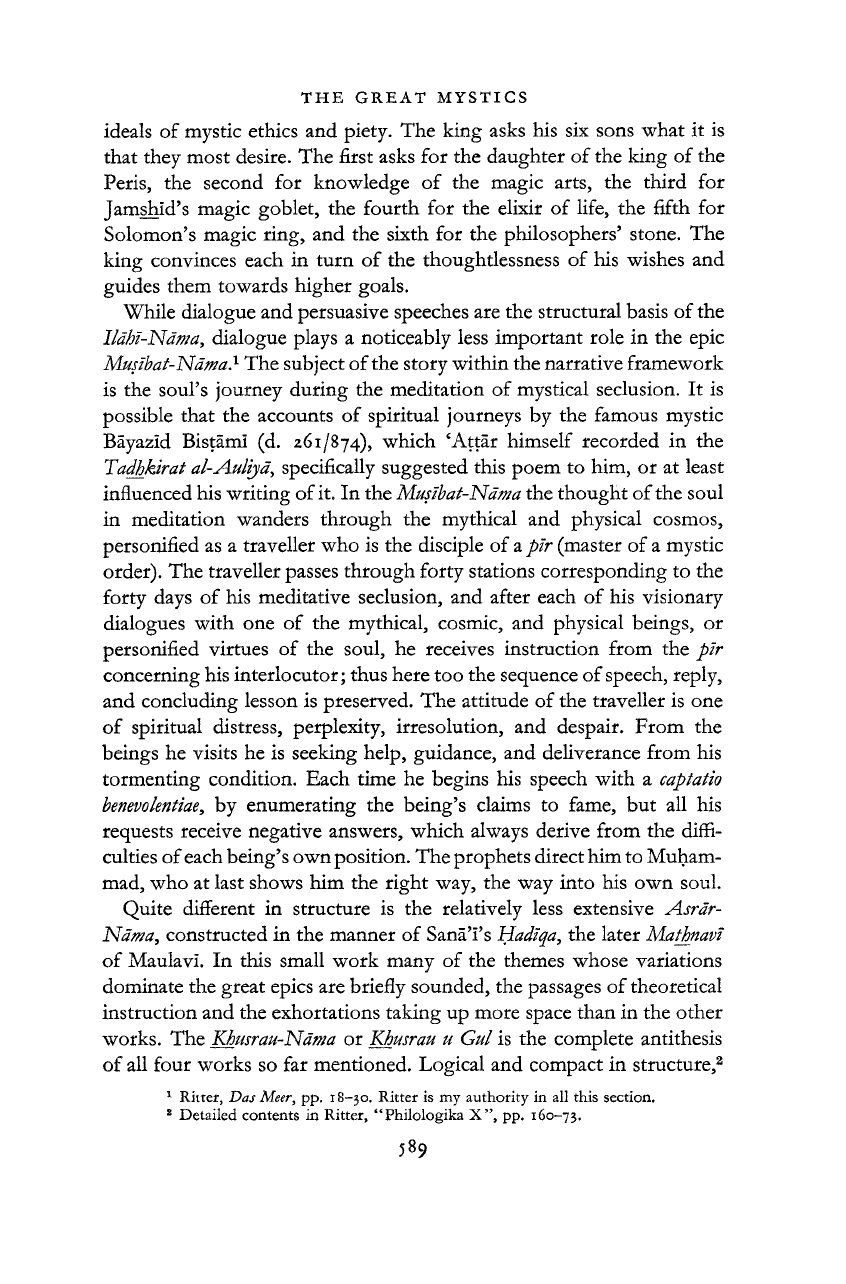
THE GREAT MYSTICS
589
ideals
of
mystic ethics
and
piety.
The
king asks
his six
sons what
it is
that they most desire.
The
first asks
for the
daughter
of
the king
of
the
Peris,
the
second
for
knowledge
of the
magic arts,
the
third
for
Jamshid's magic goblet,
the
fourth
for the
elixir
of
life,
the
fifth
for
Solomon's magic ring,
and the
sixth
for the
philosophers' stone.
The
king convinces each
in
turn
of the
thoughtlessness
of his
wishes
and
guides them towards higher goals.
While dialogue and persuasive speeches
are the
structural basis
of
the
Ildhi-Ndma,
dialogue plays
a
noticeably less important role
in the
epic
Mustbat-Ndma.
1
The subject
of
the story within the narrative framework
is
the
soul's journey during
the
meditation
of
mystical seclusion.
It is
possible that
the
accounts
of
spiritual journeys
by the
famous mystic
Bayazid Bistami
(d.
261/874), which 'Attar himself recorded
in the
Tadhkirat
al-Auliyd
y
specifically suggested this poem
to
him,
or at
least
influenced his writing
of
it.
In
the
Musibat-Ndma
the thought
of
the soul
in meditation wanders through
the
mythical
and
physical cosmos,
personified
as a
traveller
who is the
disciple
of
a
pir
(master
of
a mystic
order).
The
traveller passes through forty stations corresponding
to the
forty days
of his
meditative seclusion,
and
after each
of his
visionary
dialogues with
one of the
mythical, cosmic,
and
physical beings,
or
personified virtues
of the
soul,
he
receives instruction from
the pir
concerning his interlocutor; thus here too the sequence
of
speech, reply,
and concluding lesson
is
preserved.
The
attitude
of
the traveller
is one
of spiritual distress, perplexity, irresolution,
and
despair. From
the
beings
he
visits
he is
seeking help, guidance,
and
deliverance from
his
tormenting condition. Each time
he
begins
his
speech with
a captatio
benevolentiae, by
enumerating
the
being's claims
to
fame,
but all his
requests receive negative answers, which always derive from
the
diffi-
culties
of
each being's own position. The prophets direct him to Muham-
mad,
who at
last shows
him the
right
way, the way
into
his own
soul.
Quite different
in
structure
is the
relatively less extensive
Asrdr-
Ndma,
constructed
in the
manner
of
Sana'i's
Hadiqa, the
later
Mathnavi
of Maulavi.
In
this small work many
of the
themes whose variations
dominate
the
great epics are briefly sounded, the passages
of
theoretical
instruction and
the
exhortations taking
up
more space than
in the
other
works.
The Khusrau-Ndma or Khusrau u Gul is the
complete antithesis
of all four works
so far
mentioned. Logical
and
compact
in
structure,
2
1
Riiter,
Das
Meer, pp. 18-30. Ritter
is my
authority
in all
this section.
2
Detailed contents
in
Ritter, "Philologika
X",
pp. 160-73.
